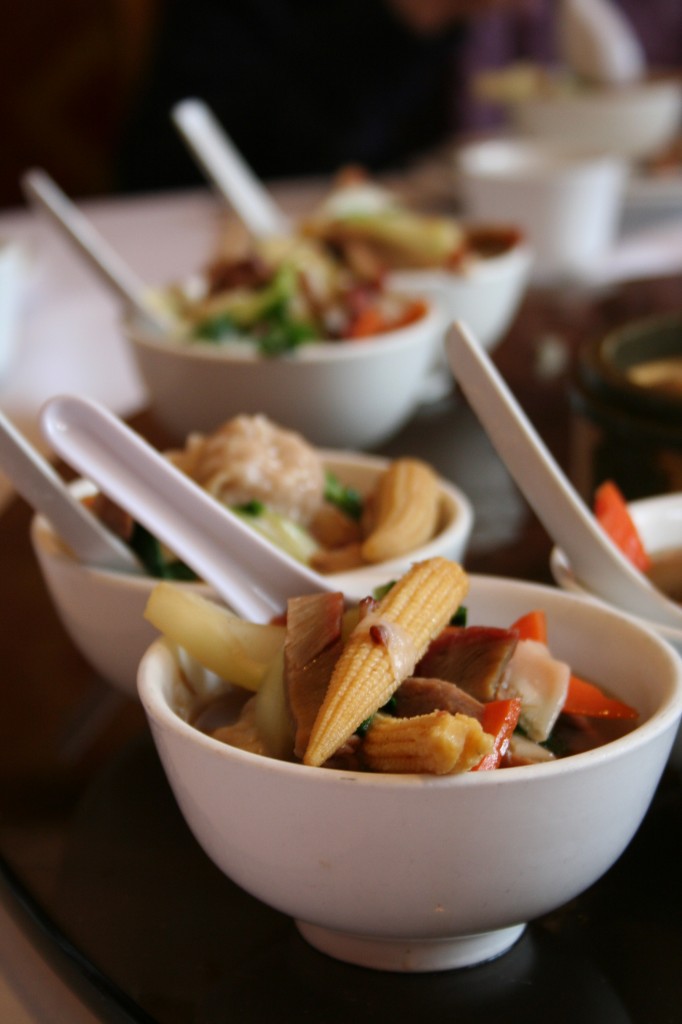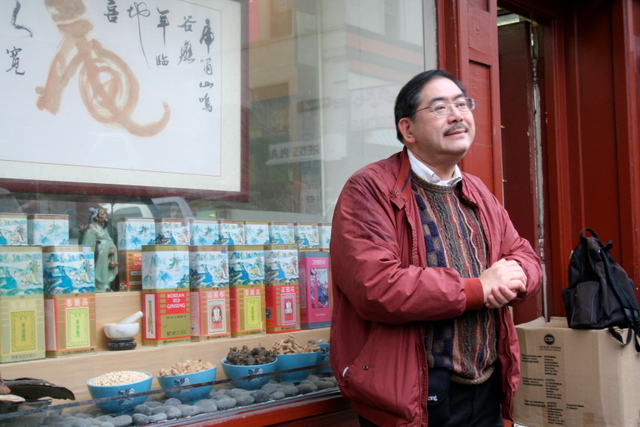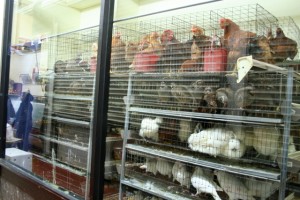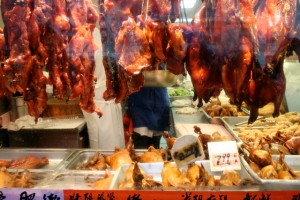Chinatown–San Francisco
Jan 21, 2011 by The Tasty Buzz

Soup at our dim sum lunch.
Whiskey, oysters, coffee, beef jerky. One of the things that most struck me most about my tour of San Francisco's Chinatown was this: the original diet of the San Francisco inhabitants before the Chinese immigrants arrived. I like to imagine a bunch of guys sitting at a make-shift table near the dock, chewing on beef jerky, a pile of pale oyster shells at their feet. It's 1848, and the bone-chilling fog is slowly breaking up under the cold sun. But it's clear enough to see the brig that just pulled into the dock this morning. Clear enough to see the man and woman, the Chinese Adam and Eve of San Francisco, that just stepped onto San Francisco soil. One guy elbows the other, knocking over his coffee tin. "Ya see that?" he says. And the other guy leans forward, peers toward the harbor at the small, dark figures approaching. "What the...?"
They never knew what was headed their way.
Told by the right storyteller, Chinatown's history is an interesting one, filled with almost Godfather-like details of immigrant families helping each other to survive, struggling against anti-immigration laws and police brutality. The Chinese reached eventual prominence in San Francisco by their sheer tenacity, surviving only by holding on to each other for dear life, like the Pacific Blue mussels clinging to the battered rocks around the Bay.
And thank god they stuck it out. Otherwise we'd have been robbed of the dim-sum, the egg rolls, the roasted duck, the rice noodles, the wonton soup. We'd have been robbed of the Chinese markets that swarm with questionable items such as dried shark fin and live pigeons and frogs, shoved in plastic bins and tiny cages.We'd have been robbed of the Buddhist temples, and the streets that are still filled with mostly Chinese residents. We'd have been robbed of that sense that you've stepped into another world entirely as you bump and shuffle through the loud and crowded markets without hearing a word of English.

Frank outside a Chinese medicine shop
I organized a Chinatown tour for my food writing class with
Wok Wiz tours (owned by Shirley Fong-Torres) and our guide, Frank, was fantastic. He told us so many great details about Chinatown's early history. When a new immigrant arrived, for example, an association would give him money, connect him with nearby family, and even help him find work, all in exchange for giving money back to the association when he got his feet on the ground.
One of the first places the associations would send residents to were the tiny apartments called SRO's (single room occupancy) where they'd share kitchens and bathrooms and a single rotary phone. If someone received a rare call from China, the SRO building would send runners to your workplace to bring you back home to take the call. (Locals still populate these apartments, by the way, one of the few places with cheap rent in the city.)

We had to walk to the back of the market to find these hidden away...
These family associations existed, in part, because the Chinese faced such fierce racism and strong anti-immigration laws as well as measures designed to stop them from buying up property. The anti-Chinese sentiment was so strong, in fact, that the ground underneath Chinatown was once riddled with tunnels that led to and from homes and shops, so people could escape when the police came looking for them.
And here's an interesting fact about North Beach vs. Chinatown that I loved, particularly since I just got back from Italy. At one point the Italians started selling off property in North Beach to the Chinese, thinking that the property values were on their way down, and the Italians would sneak off with a fantastic profit. Well, the Italians did get a great profit...but the Chinese won out in the end. Apparently the Chinese actually own about 20% of North Beach now and...get this...the Italians now rent North Beach property (for their restaurants) from the Chinese!

You've got hanging pork, roast duck, pigeons, chickens, and chicken feet--all in one window.
I could go on and on, but I don't want to spoil it all. I highly recommend you take the tour. One thing though--make sure you choose the lunch offered at the end with the walking tour. It does add another $10 I think, but don't short change yourself--it's lovely. Secondly, make sure you request to see the fortune cookie factory and the tea shop. I organized this for my university students and I saw those two and my other students didn't (we were split up because of size)...and they were not as happy with their experience. All in all though--it was a fantastic day, followed by a wonderful meal. And best of all, it's a way to really get to know Chinatown intimately--a gift if you're a tourist, and a must if you live here.
Check out more history about Chinatown
here.
And definitely visit Wok Wiz's website
here.









